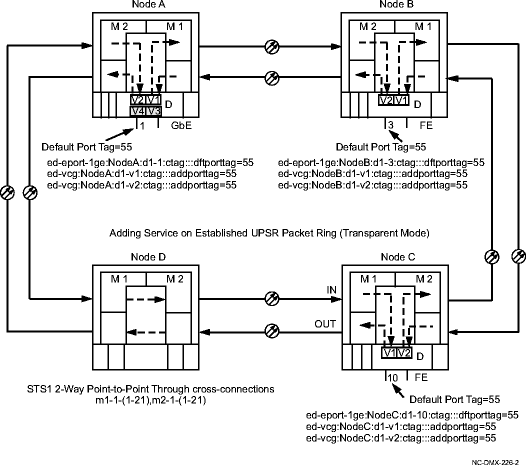Procedure 11-7: Establish transparent mode Ethernet service on established packet ring (UPSR)
 Overview
Overview
This procedure provides an example for configuring Ethernet service using the Transparent tagging mode on an established packet ring. See Figure 11-7, Example service on UPSR using transparent tagging mode for an example.
This procedure uses TL1 commands and specific WaveStar® CIT menu selections to illustrate the detailed provisioning parameters. If you prefer, you can use the Data Provisioning Wizard to perform the provisioning in this procedure. From the System View menu, select Configuration → Ethernet Service to invoke the wizard.
Important!
The packet ring must already be established on the UPSR before continuing. This procedure assumes the packet ring is established with the necessary tagging modes, virtual switch IDs, cross-connections, and spanning tree groups established. See Procedure 11-5: Establish Ethernet packet ring on a UPSR.
On connected Gigabit Ethernet devices with autonegotiation turned on/enabled, if transmission is interrupted in one direction of transmission on a Gigabit Ethernet device, then transmission will also be disabled in the other direction. For example, if one fiber in a transmit/receive pair is cut, then one-way transmission on the other fiber can be maintained only if autonegotiate is turned off/disabled and the link state is forced good at the transmit source equipment.
 Before you begin
Before you begin
Prior to performing this procedure, refer to Before you begin and Required equipment in this chapter and you must have complete work instructions for this procedure that detail:
Steps
Use this procedure as an example for configuring Ethernet service on a UPSR protected packet ring using the Transparent tagging mode. See Figure 11-7, Example service on UPSR using transparent tagging mode for an example.
1 |
Use the WaveStar® CIT to log in to one of the terminating nodes, if not already performed. Reference: Procedure 14-2: Connect Personal Computer (PC) and establish WaveStar® CIT session |
2 |
On the System View menu, select Administration → OSI Routing Map or Administration → OSI Neighbor Map to retrieve a node-to-node listing of every node in the network. Important! If a drawing of the network is not provided with the work instructions, it is recommended that you draw a simple diagram of the ring (indicating node-to-node connections) and list each node's TID. Result: The OSI Routing Map or OSI Neighbor Map window opens. |
3 |
Verify that the system configuration is the same as specified on your work instructions. |
4 |
From your work instructions, determine the terminating nodes, circuit packs, LAN ports, virtual switch ID, and VLAN IDs associated with the service being established. |
5 |
CREATE PORT TAGs Use the TL1 ed-eport and ed-vcg commands to assign port tags to the associated LAN ports and VCG WAN ports. Or, select Configuration → Data → Create Port Tag command from the CIT System View menu. Highlight the circuit pack being provisioned, then click Select. Provision the parameters as required. Click Apply, then click Yes to the warning message. Click Close to exit. The Peak Information Rate (PIR) rate limiting feature on the LNW67/LNW68 circuit packs will not be effective in transparent mode if the Ethernet Type (ethertype) parameter for the LAN or WAN VCG ports is provisioned to any value other than FFFF or 8100. |
6 |
PROVISION LAN (Ethernet) PORTS Use the TL1 ed-eport command to provision parameters for the LAN port being provisioned. Or, select Configuration → Equipment from the System View menu, expand the details for the circuit pack, highlight the LAN port, then click Select. Provision the parameters as required. Click Apply, then click Yes to execute the command. Repeat for all ports being provisioned. Click Close to exit or continue with the next step. Reference: Procedure 11-8: Provision Ethernet LAN port parameters |
7 |
PROVISION WAN (VCG) PORTS Use the TL1 ed-vcg command to provision parameters for the VCG ports, as required. Or, select Configuration → Equipment from the System View menu, expand the details for the circuit pack, highlight the VCG port, then click Select. Provision the parameters as required. Click Apply, then click Yes to execute the command. Repeat for all ports being provisioned. Click Close to exit. Reference: Procedure 11-9: Provision VCG parameters End of steps |
Figure 11-7: Example service on UPSR using transparent tagging mode
